
Physiotherapy Practice and Research
Scope & Guideline
Advancing rehabilitation through innovative research.
Introduction
Aims and Scopes
- Evidence-based practice in physiotherapy:
The journal promotes rigorous research methodologies that contribute to evidence-based practice in physiotherapy, ensuring that clinical decisions are informed by the best available evidence. - Innovative rehabilitation techniques:
It explores and evaluates new and innovative rehabilitation techniques, particularly those that enhance functional outcomes for various patient populations. - Multidisciplinary approaches:
The journal encourages studies that involve multidisciplinary approaches to rehabilitation, highlighting collaborations among physiotherapists, occupational therapists, and other healthcare professionals. - Patient-centered care:
Research focusing on patient experiences, preferences, and outcomes is a core area, emphasizing the importance of tailoring interventions to meet individual patient needs. - Community health and preventive care:
The journal addresses issues related to community health, emphasizing preventive care strategies that physiotherapists can implement to improve public health outcomes.
Trending and Emerging
- Telehealth and remote rehabilitation:
The rise of telehealth and remote rehabilitation solutions has gained significant attention, especially following the COVID-19 pandemic, as physiotherapists explore ways to deliver care effectively through digital platforms. - Holistic and integrative care models:
There is an increasing focus on holistic care approaches that integrate physical, psychological, and social factors into rehabilitation, reflecting a broader understanding of patient wellness. - Technology in rehabilitation:
Emerging themes include the use of technology, such as wearable devices and apps, in monitoring and enhancing rehabilitation outcomes, showcasing a trend towards data-driven physiotherapy. - Focus on chronic conditions and geriatric care:
Research is increasingly targeting chronic conditions and geriatric populations, addressing the growing need for effective rehabilitation strategies in aging patients. - Patient-reported outcomes and experiences:
There is a notable trend in emphasizing patient-reported outcomes and experiences, highlighting the importance of subjective measures in evaluating the effectiveness of physiotherapy interventions.
Declining or Waning
- Traditional manual therapy techniques:
There is a noticeable decrease in publications related to traditional manual therapy techniques, suggesting a shift towards evidence-based and innovative approaches in rehabilitation. - Generalized pain management approaches:
Research focusing on generalized pain management strategies without specific context or targeted interventions appears to be waning, indicating a movement towards more specialized and evidence-based pain management practices. - Static exercise regimes:
The frequency of studies on static exercise regimes has diminished, as there is a growing emphasis on dynamic and functional training approaches that facilitate better patient outcomes. - Single-discipline focused research:
Research that only examines physiotherapy without considering multidisciplinary perspectives is becoming less common, reflecting a trend towards integrated care models that include various healthcare disciplines. - Basic anatomical studies:
Papers that focus solely on basic anatomical studies without clinical application or relevance to current physiotherapy practice are less frequently published, as the field increasingly values applied research.
Similar Journals

International Journal of Physiotherapy
Connecting Minds: Global Perspectives in Rehabilitation SciencesThe International Journal of Physiotherapy, published by IJPHY Publishers, is a distinguished platform committed to advancing the field of rehabilitation sciences and physiotherapy. With an ISSN of 2349-5987 and E-ISSN of 2348-8336, this Open Access journal has been facilitating global knowledge sharing since 2014. Located in the culturally rich city of Tirupati, Andhra Pradesh, India, the journal aims to provide comprehensive research findings, innovative therapeutic techniques, and insightful reviews in physiotherapy, thus catering to academics, clinicians, and researchers alike. By allowing unrestricted access to its content, the journal promotes the dissemination of evidence-based practices, thereby enhancing the quality of care and fostering professional development in the field. With a growing repository of scholarly articles and a commitment to maintaining high publication standards, the International Journal of Physiotherapy is poised to become an essential resource for anyone dedicated to the pursuit of knowledge in physiotherapy and rehabilitation.

European Journal of Physiotherapy
Empowering practitioners through innovative research.The European Journal of Physiotherapy is a leading scholarly publication dedicated to advancing the field of physical therapy, sports therapy, and rehabilitation. Published by Routledge Journals, Taylor & Francis Ltd, this journal serves an international audience and is recognized for its contributions to the understanding and practice of physiotherapy, with a notable Q2 ranking in its category for 2023. The journal covers a wide range of topics relevant to contemporary physiotherapy, emphasizing innovative research and clinical practices that shape the discipline. With its ISSN 2167-9169 and E-ISSN 2167-9177, the journal promotes accessibility to high-quality research without open access limitations. Based in the United Kingdom, the European Journal of Physiotherapy plays a crucial role in disseminating knowledge within the health professions, offering valuable insights for researchers, practitioners, and students alike. With a Scopus rank of 104/247 in the health professions category, it stands at the forefront of academic discourse, paving the way for advancements in therapeutic practice and patient care.

Current Physical Medicine and Rehabilitation Reports
Empowering Professionals Through Cutting-Edge ResearchCurrent Physical Medicine and Rehabilitation Reports, published by SpringerNature, is an esteemed academic journal dedicated to advancing the fields of physical medicine and rehabilitation. With a focus on disseminating high-quality research and evidence-based practices, this journal covers a broad spectrum of topics including orthopedic medicine, sports therapy, and comprehensive rehabilitation strategies. While it currently holds a Q3 quartile ranking across several related categories, including medicine and rehabilitation, the journal aims to elevate its impact through open access to its content, fostering a global discussion amongst researchers, professionals, and students alike. Navigating the intersections of innovation and clinical application, Current Physical Medicine and Rehabilitation Reports serves as a vital resource for those seeking to enhance their understanding and practice in this dynamic field. With its evolving scope, the journal is committed to publishing studies and reviews that shape the future of rehabilitation and physical medicine practices.

Frontiers in Rehabilitation Sciences
Driving knowledge exchange in the evolving field of rehabilitation.Frontiers in Rehabilitation Sciences, published by FRONTIERS MEDIA SA, is an innovative open-access journal that has been committed to advancing the discipline of rehabilitation science since its inception in 2021. The journal aims to serve as a platform for researchers, clinicians, and students interested in disseminating high-quality research and insights that drive practice and policy in rehabilitation and physical therapy. With an E-ISSN of 2673-6861, it fosters interdisciplinary collaboration, tackling topics that range from therapeutic interventions to sports rehabilitation and beyond. As part of the Frontiers family, the journal employs cutting-edge open-access policies that ensure widespread dissemination and visibility of research findings. Although it is currently ranked within the lower quartiles based on Scopus rankings, the journal provides an invaluable opportunity for emerging scholars to publish their work in a rapidly evolving field. By sharing knowledge and fostering dialogue among scientists and practitioners alike, Frontiers in Rehabilitation Sciences plays a crucial role in shaping the future of rehabilitation methodologies and improving patient outcomes.
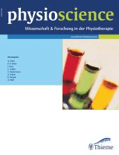
Physioscience
Advancing knowledge in physiotherapy and rehabilitation.Physioscience is a premier academic journal dedicated to the evolving field of physiotherapy and rehabilitation sciences, published by the esteemed GEORG THIEME VERLAG KG. The journal serves as a crucial platform for researchers, clinicians, and practitioners to disseminate cutting-edge research, innovative practices, and comprehensive reviews aimed at enhancing patient care and advancing the knowledge base in physical therapy. Although Physioscience does not operate under an open access model, it ensures wide visibility and accessibility of scholarly articles through esteemed databases. Its rigorous peer-review process guarantees the highest quality of published content, thereby maintaining its reputation as a leading resource for both fundamental research and clinical applications in physiotherapy. Positioned significantly in the health sciences field, Physioscience strives to foster interdisciplinary collaboration and stimulate ongoing dialogue among healthcare professionals, ultimately aiming to inform best practices and improve clinical outcomes worldwide.
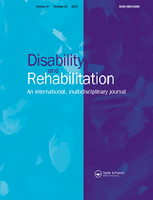
DISABILITY AND REHABILITATION
Pioneering Research for Effective Rehabilitation Practices.Disability and Rehabilitation, a prestigious journal published by Taylor & Francis Ltd, plays a critical role in the field of rehabilitation science. Since its inception in 1978, this journal has been dedicated to presenting high-quality research focused on improving the lives of individuals with disabilities through innovative rehabilitation techniques and healthcare solutions. With an impressive Q1 ranking in the Rehabilitation category and a Scopus rank of #24 out of 161, the journal is recognized for its significant impact and rigorous scholarly contributions, boasting an 85th percentile performance among peers. Although it operates under a subscription model, the journal remains a vital resource for researchers, healthcare professionals, and students seeking the latest insights and developments in the realm of disability and rehabilitation. Covering a broad spectrum of topics, from clinical practices to theoretical advancements, Disability and Rehabilitation continues to shape the future of rehabilitation research and practice worldwide.
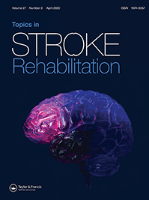
Topics in Stroke Rehabilitation
Advancing knowledge in stroke rehabilitation.Topics in Stroke Rehabilitation, published by Taylor & Francis Ltd, stands as a premier academic journal offering cutting-edge research and insights in the fields of rehabilitation, neurology, and community care. With an impressive impact factor reflecting its strong scholarly influence, this journal not only maintains a distinguished Q1 ranking in Community and Home Care and Rehabilitation but is also recognized in the Q2 category for Clinical Neurology, showcasing its relevance across multiple disciplines. Covering a comprehensive range of topics from neurorehabilitation techniques to patient-centered care strategies, Topics in Stroke Rehabilitation serves as an essential resource for researchers, healthcare professionals, and students dedicated to enhancing the quality of life for individuals recovering from stroke. With an accessible archive dating back to 1996 and continuous publication through 2024, this journal invites collaboration and discourse, fostering advancements in both theoretical knowledge and practical applications within the realm of stroke rehabilitation.

International Journal of Therapy and Rehabilitation
Exploring New Horizons in Therapy and RehabilitationInternational Journal of Therapy and Rehabilitation (ISSN: 1741-1645; E-ISSN: 1759-779X), published by MA HEALTHCARE LTD, is a premier platform for disseminating innovative research and clinical practices in the fields of physical therapy, sports therapy, and rehabilitation. As an influential contributor to the academic discourse in rehabilitation, this journal holds a notable impact factor and is recognized in the Q4 category in Physical Therapy, Sports Therapy and Rehabilitation and Q3 in Rehabilitation as of 2023. With rankings of #112 out of 161 and #190 out of 247 in Scopus, respectively, it remains committed to publishing high-quality research that addresses both the fundamental and contemporary challenges in therapy and rehabilitation. While the journal does not offer open access, it strives to present content that is highly relevant and impactful for practitioners, researchers, and students in the healthcare community. The journal's scope, spanning from 1996 to 2024, reflects its dedication to reflecting the evolving nature of therapy and rehabilitation practices globally.
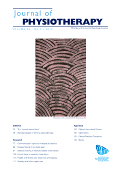
Journal of Physiotherapy
Empowering Rehabilitation with Evidence-Based InsightsThe Journal of Physiotherapy, published by the Australian Physiotherapy Association, is a leading peer-reviewed journal dedicated to advancing the field of physical therapy, sports therapy, and rehabilitation. With a stellar impact factor and ranked Q1 in the 2023 category of Physical Therapy, this journal serves as an essential resource for researchers, clinicians, and educators alike. Located in Australia, it features open access options that allow global dissemination of knowledge, enhancing the visibility of cutting-edge research from 2010 to 2024. With a commendable Scopus Rank of #5 out of 247 in its field, achieving the 98th percentile, the Journal of Physiotherapy is committed to enriching the evidence base within the profession and promoting best practices in physiotherapy. Whether you are searching for the latest clinical studies, innovative treatments, or comprehensive reviews, this journal provides a platform for high-quality scholarship that drives the profession forward.
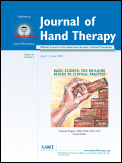
Journal of Hand Therapy
Innovating rehabilitation strategies for optimal patient outcomes.Welcome to the Journal of Hand Therapy, a premier publication dedicated to advancing the field of hand therapy through rigorous research and clinical insights. Published by Hanley & Belfus-Elsevier Inc, this esteemed journal, with ISSN 0894-1130 and E-ISSN 1545-004X, has been a cornerstone for professionals since its inception in 1987. With a commendable impact factor and categorized in the Q2 and Q1 quartiles for Physical Therapy, Sports Therapy, Rehabilitation, and Medicine, it ranks among the top journals in its fields, listed at #46/161 and #78/247 respectively in Scopus rankings. The journal aims to disseminate innovative research, evidence-based practices, and comprehensive reviews, addressing contemporary challenges in hand therapy, making it an essential resource for researchers, practitioners, and students alike. With a commitment to enhancing patient care, Journal of Hand Therapy is your gateway to the latest developments and trends in this critical area of rehabilitation.